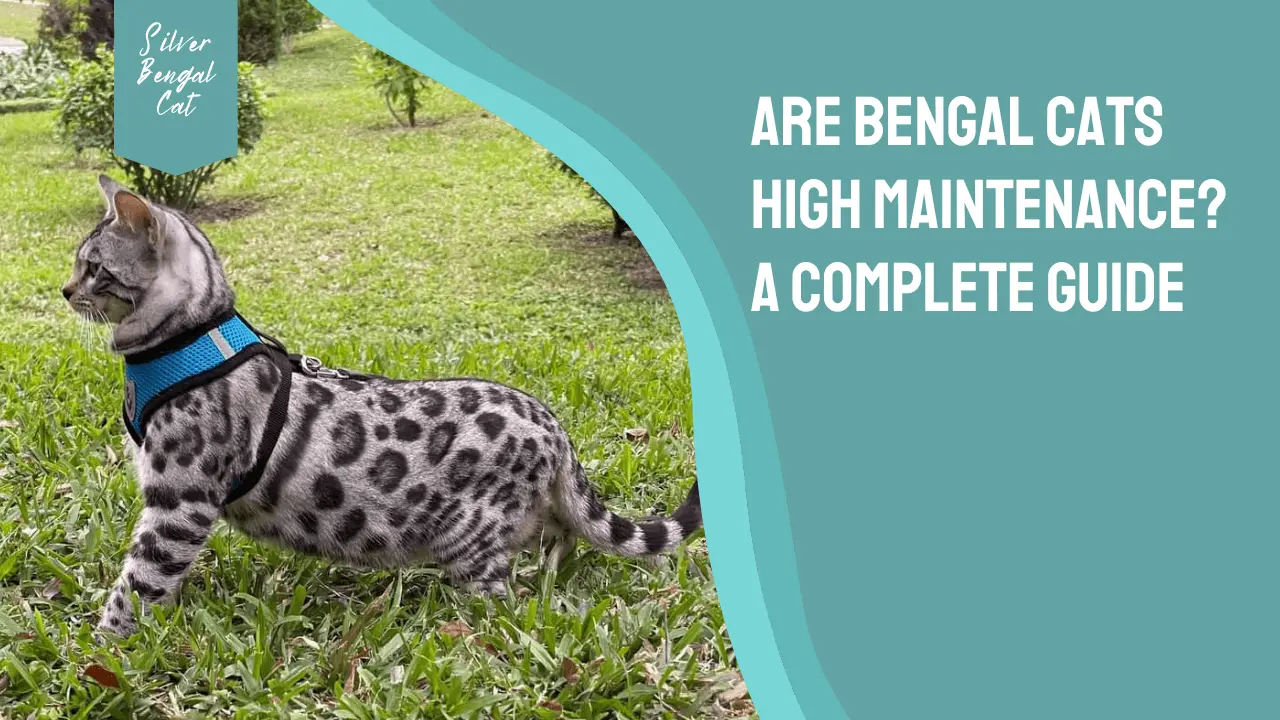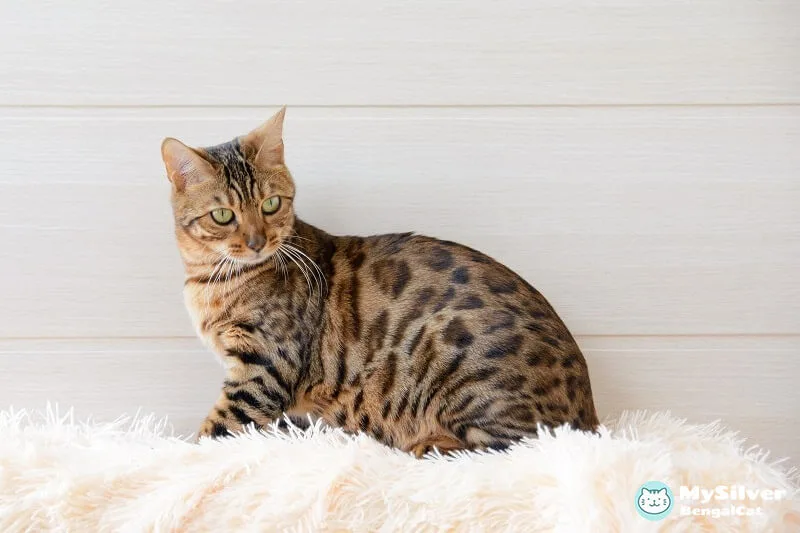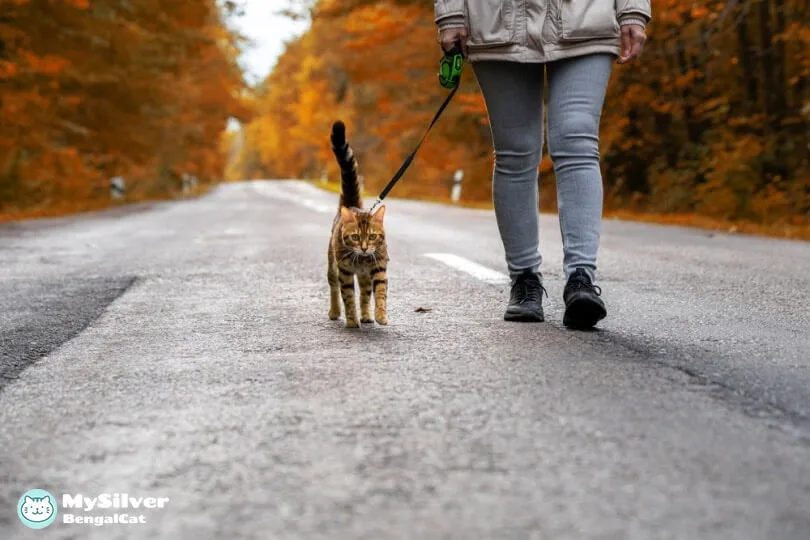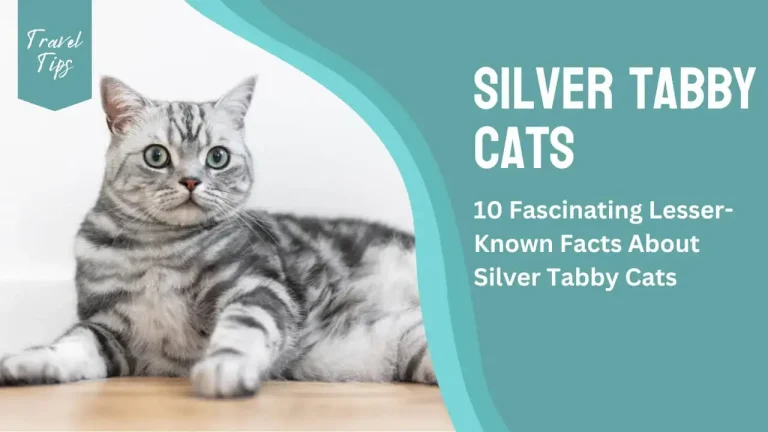Are Bengal Cats High Maintenance? Guide to Grooming, Exercise & Health

Few breeds can match the charm of the Bengal cat. The International Cat Association states this stunning breed has been the most famous cat breed for three years. Nevertheless, owning a Bengal cat has some responsibilities that must be addressed. These cats require more attention than other cat breeds in terms of daily care, training, socialization, possible health issues, and ownership costs. So, let’s dig deeper and find out; Are Bengal cats high maintenance?
Maintenance Needs Of Bengal Cats In A Nutshell
Characteristics: Why Are Bengal Cats High Maintenance?
Due to their unique physical and behavioral characteristics, Bengal cats differ from other domestic cats. Therefore, understanding these characteristics is critical to assess Bengal cats’ maintenance requirements.
Physical Characteristics Of Bengal Cats
- Soft coats with distinctive rosette spots
- Muscular build requiring regular exercise
- Larger size, weighing between 8 and 15 pounds
Behavioral Characteristics Of Bengal Cats
- High energy levels, needing daily exercise
- Playful and active nature, requiring frequent interaction
- High intelligence, needing mental stimulation to prevent boredom
- Affectionate and forming close bonds with owners

Health Concerns Of Bengal Cats
Bengal cats generally have good health, but they can be vulnerable to a few conditions, such as:
Upper Respiratory Infection
Bengal cats can get cold-like respiratory infections caused by viruses or bacteria. Symptoms may include sneezing, runny nose, coughing, and fever. Regular veterinary care and vaccinations help prevent these infections.
Kidney Disease
Bengal cats are prone to kidney disease, which can cause a gradual loss of kidney function. Signs may include increased thirst, weight loss, and decreased appetite. Monitoring kidney health through tests, proper hydration, and a balanced diet is essential.
Liver Disease
Bengal cats may develop liver diseases like fatty liver or liver inflammation. Symptoms include yellowing skin/eyes, loss of appetite, and weight loss. Regular vet check-ups, good nutrition, and timely treatment are crucial for managing liver disease.
Heart Disease
Heart failure is brought on by the genetic heart condition known as hypertrophic cardiomyopathy, which causes the heart muscles to thicken. The easiest way to avoid this disease is by checking your Bengal cat’s diet and providing physical stimulation.
Eye Diseases
A genetic eye condition called progressive retinal atrophy causes progressive blindness. Checking Bengal cats for this condition and monitoring their vision is crucial.
Hip Dysplasia
This disease affects the hip joint and can lead to mobility issues. Signs may include difficulty jumping and abnormal walking. Diagnosis involves exams and X-rays. It may make walking painful and challenging.

Top 5 High Maintenance Cats
Bengal Cat Care: Routine Requirements
- Feeding: Bengal cats need a high-quality, protein-rich diet to maintain their health and energy levels. They typically consume dry or wet cat food formulated to meet their dietary requirements. It is crucial to follow the feeding recommendations made by the food producer and to keep an eye on their weight to ensure they are manageable Read more about Silver Bengal Cat Feeding Guidelines.
- Shedding and grooming: Bengal cats have short, dense coats that only need occasional brushing. Once a week, brushing is recommended to remove loose hair and distribute skin oils. Additionally, they might require routine nail trimming and tooth brushing to avoid dental problems.
- Exercise: Because they are athletic and active, Bengal cats need regular exercise to stimulate their bodies and minds. They should be given toys and interactive playtime with their owners to keep them entertained and involved.
Bengal cats may need more playtime and exercise than other cat breeds to maintain good physical and mental health. They may require more care and playtime than other cat breeds because of their high energy levels and need for stimulation.
Socialization and Training
Training and socialization are crucial for Bengal cats to develop good behavior and comfort in their homes. These intelligent and curious cats need mental stimulation and obedience training to prevent trouble. Socialization is also important for avoiding anxiety and aggression in new situations
Early exposure to different people, animals, and environments can help Bengal cats feel more comfortable. However, maintaining good behavior requires ongoing care and training from their owners. To ensure their maintenance needs are met, Bengal cats may need more attention and effort spent on socialization, including visits to new places and interactions with other animals.

Ownership Cost
Before deciding to adopt a Bengal cat, one must consider the expenses involved in owning one. While costs can vary depending on where you live, the cat’s age, and availability, Bengal cats generally have higher ownership costs than other breeds.
This is because Bengal cats may have more health and behavioral issues that require additional veterinary care and mental stimulation. This might mean spending extra on toys or equipment to keep them entertained.
They also have similar costs for food and litter, but potential behavioral problems like spraying or destructive behavior can add to the expenses. However, if you’re willing to invest in their care and give them the attention they need to stay healthy and happy, owning a Bengal cat can be a rewarding experience.
Final thoughts!
Caring for Bengal cats requires extra effort and focus, but their love and happiness make it all worth it. Keeping them healthy and happy involves grooming them daily, teaching them good behavior, and helping them socialize.
It may cost more to care for Bengal cats, but the rewards of having them as companions make the investment satisfying. Whether you already have a Bengal cat or are considering adopting one, knowing and meeting their needs is essential to enjoy a long and joyful life together.
FAQs






